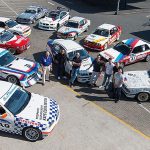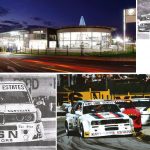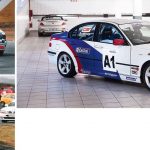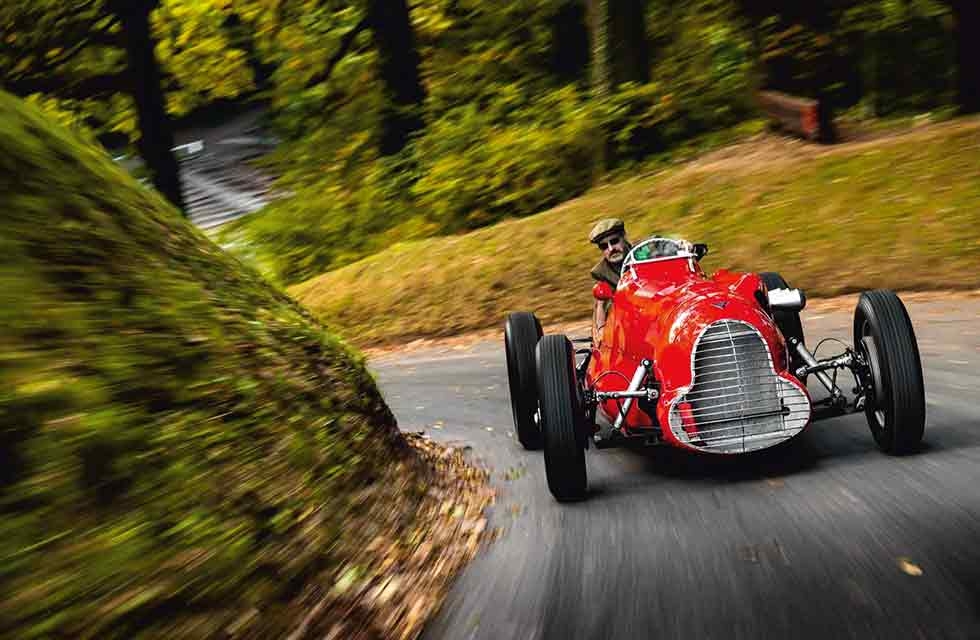
Special Sauce This monoposto wouldn’t seem out of place on a Grand Prix grid, but it’s actually a hillclimb special built in Macclesfield. Nigel Boothman finds out whether reality lives up to the looks. Photography Jonathan Fleetwood.
ALVIS GOODWIN SPECIAL
One-off ’50s hillclimber that looks like a GP car
It’s a hefty so-and-so. There’s no spidery spaceframe under that taut red skin – quite the opposite, really, with a twin-tube chassis braced by channel sections welded underneath. And most of the oily bits are from an Alvis 4.3-litre, not exactly the last word in featherweights. So push-starting it up a gentle slope in the Shelsley Walsh paddock is a task that gets you breathing… especially when the brakes are binding.
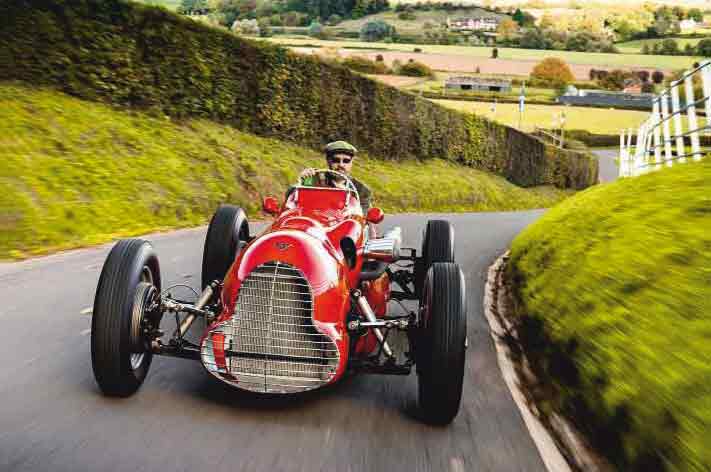
We’re here to let the car stretch its legs at its most successful stamping ground. Perhaps because of today’s VSCC hillclimbs we tend to think of Shelsley Specials, those home-built contraptions designed purely to dash up hills like this, as pre-war machines. But the golden age of speed hill-climbing in this country was arguably in the ten years after the war, when a nation starved of much motorsport lapped up the British Hill Climb Championship every summer. Pick up an elderly copy of The Autocar from a week following an event and a lavishly illustrated hillclimb spread will be the first thing in the sports pages – trumping any foreign GP, for example.
‘In the metal, it really does have the presence and proportions of a Grand Prix car’

Raymond Mays, Sydney Allard, Dennis Poore, Joe Fry, Ken Wharton, Basil Davenport, John Bolster… they filled the top ten, split between those in re-purposed racing cars – Poore’s 8C Alfa, Mays’ ERA, Wharton’s Cooper – and those in self-built specials, such as Fry’s Freikaiserwagen, Bolster’s Bloody Mary and Allard’s tank-engined Steyr-Allard. Resembling the former category but belonging to the latter was this car, the Goodwin Special.
‘A few seconds of whirring, then a guttural boom as it catches. What does it sound like? Think vintage aircraft’
William and Eric Goodwin ran an engineering firm near Macclesfield in Cheshire. Both brothers were skilled, experienced competitors who at other times ran an ERA and a Kieft 500, but in 1948 Billy kicked off the construction of a special. And what he chose to create was pretty ambitious.
Indeed, the chassis and suspension design define it as a one-off racer constructed to professional standards rather than a home-built special. Goodwin’s own engineering firm is thought to have fabricated the chassis, which is stiffened by front and rear crossmembers and by the four-point mounting of the Alvis engine as a partially stressed member.
At the rear is a specially built differential casing once housing an Alvis 3.8:1 crownwheel and pinion, now replaced with a 3.77:1 Powerlok, as found in many Salisbury axles. It began life with a lower wishbone and an upper link formed from the transverse leaf spring, but this set-up broke driveshafts until upper wishbones were added to stabilise everything. At the front, a pair of 1947 Humber Super Snipe wishbones rest above hubs from the same source, with fabricated lower wishbones meeting Jaguar torsion bars on each side, running back to an adjustment point beneath the driver.
When you think of the overhead-cam layout of exotic Italian racers or even Jaguar’s roadgoing XK120, Goodwin’s choice of pushrod Alvis power ties the car to an earlier era, but this was race-car building in a time of austerity. Suitable engines were scarce. Anyway, Goodwin had a solution to any shortfall in power: a Centric supercharger acquired from Goldie Gardner and mounted behind the radiator. It all drove through an ENV preselector ’box until the transmission wilted under the 250bhp-plus and immense torque from the blown Alvis engine, so an all-synchro Alvis ’box from a Silver Crest took its place as the engine was developed season-by-season to perhaps near 300bhp. In all, Goodwin probably spent £3000 on the project when new.
In the metal, it really does have the presence and proportions of a Grand Prix car. It’s similar in aspect and attitude to a Ferrari 375 GP and a Talbot-Lago T26-C, but most of all it resembles the Alfa-Romeo 159; that pear-shaped wire grille is awfully like the one the Alfetta wore in 1951. Last September I saw how it might have fared against some late-1930s and 1940s GP rivals when the car took part in the Goodwood Trophy at the Revival Meeting. Alex Simpson, the car’s caretaker and driver, started around two-thirds of the way back, shot past two people the moment the flag dropped and made up places steadily to the finish. Watching him guide the big special through St Mary’s with unflustered ease while those around him sawed at the wheel, elbows flying, suggested the potential to go quite a lot faster. But more of that later.
After some very successful years campaigning the car on the hills, Billy Goodwin took his special for a rare circuit outing at Oulton Park. He was approaching Knicker Brook at 115mph when the header tank, located in the scuttle above his legs, burst and scalded him severely. He spent six weeks in hospital and decided to part with the car. It passed through some other hands, continuing in competition until it ended up with a Derbyshire farmer, who fitted wings, lamps, a starter and battery, replacing the supercharger with an orange box to carry groceries. He even managed to arrange a tow hitch and apparently pottered about with the twin rear wheels still in place, towing a pig in a trailer…
By the mid-1960s the car had been liberated from his care and restored in tuned but unsupercharged form, actually making an appearance at an early historic car race at Goodwood on Whit Monday in 1965, when it was only around 16 years old. Its last active period was with the VSCC in the early 1970s, but after that it wasn’t seen in public except for a stay with the Brooklands Museum. Alex Simpson acquired the car a couple of years ago from Alan Stote of Red Triangle, on behalf of a customer.
Alex runs Alvis specialist Earley Engineering. They performed an extensive recommissioning job on the Goodwin and rebuilt the engine. It’s since changed hands to the current owner, a Scandinavian anglophile with strong feelings about how and where such cars should be used, who asked Alex to get it on track. In Alex’s increasingly capable hands it’s climbed the course at Chateau Impney as well as performing faultlessly on its big day out at Goodwood.
Today, push-starting doesn’t answer, so Lee Taylor, Alex’s assistant, plugs the small racing battery into a socket by the driver’s right thigh. Next to the other leg, adjacent to the handbrake, is the fuel tap – across and down for ON. Alex flicks the fuel pump’s toggle switch on the dash, does the same with the ignition switch, and waits for Lee to position himself as a human choke across the three gaping SUs emerging from the nearside of the engine cover. With plastic cups (actually old grease pots) just the right size to cover the trumpets of the front and rear carbs, he rests his thigh against the middle one and nods to Alex who presses the starter.
A few seconds of whirring revolutions and then a guttural boom as it catches. What does it sound like? Think vintage aircraft, but despite the penetrating idle it’s not deafening. Some of Alvis’s quiet good manners have survived, though the engine now makes around 220bhp with a 10:1 compression ratio and no blower. More important than the power figure is a daunting 365lb ft of torque, which draws attention to the rear tyres. We’re in 2018 Goodwood set-up today, not the 1950s Shelsley format with twinned rear rims. Those contact patches look pretty titchy.
What with a cold, peaky engine running on 103-octane race fuel, tall gearing, tyre-frying torque and a course only a little wider than the car – with absolutely no run-off, unless you count a plunge down a grassy slope – I’m quite content to leave the driving to Alex for our photography runs. The view at the Shelsley startline is about as evocative as Historic motorsport gets. There’s very little of the 21st Century to mess it up, and something about Shelsley’s relaxed, old-school attitude (no officious minders in hi- vis, no 4x4s with flashing lights) makes it easy to imagine we’re here for a pre-season test in the early 1950s.
This car held the record for the ‘Shelsley Special’ class in 1952, with a period best of 39.7 seconds. Regular ascents between that figure and the low 40s saw three First in Class performances and two seconds between 1951 and ’55. Impressively, Alex has now run 37.5sec; it would be capable of 35, he says, ‘if I got braver’. For a moment I think he’s about to prove it, as the big six opens its lungs and flings the car forward, adding another pair of rubber stripes to the warm-up area. But full-chat ascents are not on without marshalling, so we have to behave.
Nonetheless, it’s clear that the car wants to go very much faster than it’s allowed to. This is partly down to the gearing, which means almost the whole climb would be done in second gear, with just a couple of moments in third, but also down to a power curve that makes it grumpy below around 2000rpm and then brings the engine on-cam with a remarkable long-legged surge. Whenever Alex needs to catch up with the camera car, or is released to shoot away towards the finish line, there’s a bellow and a rush of acceleration that wags his head backwards.
And now it’s my turn. Even with the button-in leather seat removed, I find the gearstick and steering wheel competing to trap my right knee, and the tight footwell means that driving without shoes is the only solution. This is a challenge, as Earley Engineering’s exacting rebuild of the car to race-readiness has removed all trace of slop from every control. Touch the throttle and the SUs gulp in unison, the exhaust booming a split-second later. Move the clutch, and you soon discover it’s more of a switch than a progressive feed-in. Luckily the brakes are equally powerful: twin leading-shoe hydraulics from an Alvis TA21 in light-alloy drums. Yet it’s not stroppy, forbiddingly fierce or awkward. It just likes firm inputs. Once you’re used to the central accelerator and underthigh gearchange (heavy but precise, with excellent syncromesh), everything is there for you to exploit: neat steering, not too heavy and with plenty of lock; what feels like a perfect ratio of wheelbase to track encouraging you to go faster and steer it on the throttle. Not that you should try this in your socks during a quick blat at Shelsley Walsh, where a bank of railway sleepers is likely to be the first thing you touch when you overcook it. I get just enough of a glimpse of this car’s capabilities – the huge, thrilling power, the lovely engineering – to tell that a very good, very brave driver could set some astonishing times. There’s a word for racing cars that feel like this: sorted.
Except it isn’t, or not in its final form, anyway. Since we took our pictures, Alex and the car’s owner have been planning a return to 1950s specification, as Alex explains. ‘We’re going to supercharge it again. We managed to find a Centric blower and we can put it back exactly as original. But we’ll be running it in un-blown form in the early part of this season because we got an invite to Goodwood Members’ Meeting in April and there’s not enough time to engineer everything before then.’
Alex’s plan is to feed the Alvis unit on methanol, requiring two very large SUs, each with twin float chambers, fixed as close as possible to the blower’s inlet. ‘I reckon 5500rpm is in reach,’ says Alex. ‘We’ll fit two blowoff valves to help control that, but at 16psi of boost I think we’ll make 350bhp-plus and more than 400lb ft of torque.’ Bear in mind that, even without the blower, it makes 100bhp more than a 4.3-litre Alvis saloon and weighs half as much. At Goodwood it was exceeding 130mph on the Lavant Straight. To me, it’s a vastly exciting, tractable, well-adjusted car without the supercharger, but then it isn’t wimps like me who create and compete in these amazing specials. For that, we need people like the car’s owner and Alex Simpson, and – most of all – Billy Goodwin. He built a brilliant machine and it deserves to be better known.
THANKS TO the car owner, Earley Engineering (www.earleyengineering.co.uk) and Shelsley Walsh. See www.shelsleywalsh.com for details of this year’s events: Classic Nostalgia, sponsored by Octane, is on 15/16 June.
TECHNICAL DATA FILE SPECIFICATIONS 1948 Goodwin Special
Engine 4387cc OHV straight-six, three 2in SU carburettors, Scintilla magneto ignition
Max Power 220bhp @ 4500rpm (unsupercharged)
Max Torque 325lb ft @ 1900rpm (unsupercharged)
Transmission Four-speed manual, all synchromesh, rear-wheel drive
Steering Rack and pinion
Suspension Front: double wishbones, torsion bars, telescopic dampers. Rear: double wishbones, transverse leaf springs, telescopic dampers
Brakes Hydraulic drums
Weight 809kg (dry)
Top Speed 142mph (on current gearing)
Clockwise from left Period shot of the Goodwin Special in action; 800kg isn’t light for a single-seater, so push starts aren’t easy; at the bottom of the Shelsley Walsh hillclimb course: what an evocative sight. Clockwise from bottom right Alvis straight-six currently offers 220bhp; Shelsley Walsh paddock has barely changed since the Goodwin Speical was built – and neither has the course; Humber wishbones and Jaguar torsion bars are used in front suspension.
Above from far left Uncompromising cockpit forces gearlever under driver’s right thigh, but what a view forwards; Alex Simpson of Alvis specialist Earley Engineering prepared the car for its return to Goodwood. Above and below Alvis aficionado Boothman takes his turn behind the wheel at Shelsley Walsh – and it’s obvious in these pictures just how much like a Grand Prix racer the Goodwin Special looks.

